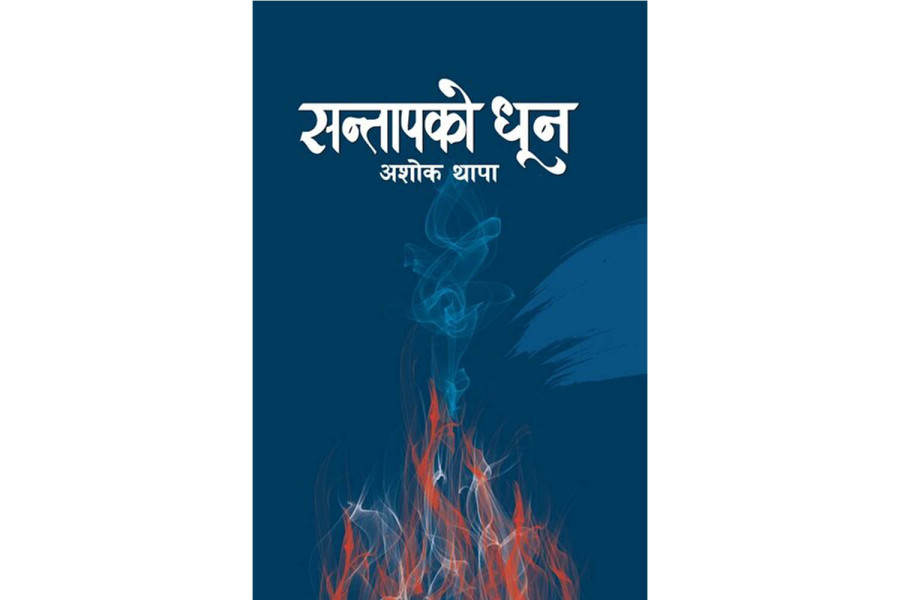Books
Hidden struggles in society
Ashok Thapa’s collection of short stories ‘Santapko Dhoon’ tackles taboo subjects like vaginal trauma, toxic masculinity, and incest.
Sanskriti Pokharel
I had never encountered topics like vaginal trauma, toxic masculinity, incest, or adultery in any book by a Nepali author until I read ‘Santapko Dhoon’ by Ashok Thapa. A discussion among my college peers about this work sparked my interest, prompting me to buy and read it.
‘Santapko Dhoon’ is a collection of thirteen short stories that explores often silenced and overlooked aspects of Nepali society. It gives a voice to the voiceless and sheds light on social issues rarely addressed.
From childhood nostalgia and love to societal issues, the recurring themes in this short story collection are intense, making it a compelling read.
The book starts with ‘Hattichap Chappal,’ a story that uses a childhood memory of unreliable slippers to explore life’s unpredictability. The protagonist's inability to join a dictation competition with his crush, all due to a small slipper malfunction, illustrates how seemingly insignificant events can be important.
The story revolves around a missed opportunity and how something minor, such as broken footwear, can impact someone’s future. I was moved by how the character and his crush couldn’t attend the dictation competition simply because of a snapped slipper strap. Missing out on a meaningful shared moment with someone you care about can be disheartening, especially due to an unforeseen circumstance beyond your control. Attending the event together could have been a chance to bond, create memories, and possibly grow closer.
Even though it’s just a broken slipper strap, it feels like a metaphor for the obstacles standing between you and the relationship you long for. The disappointment is tangible. Thapa dramatises the absurd by skillfully drawing emotions from everyday objects, using his ability to turn the mundane into something emotionally charged.
The fourth short story, ‘Vaginal Trauma’, stood out to me for its raw and intimate exploration of love, bodily autonomy, and societal expectations. It simultaneously critiques patriarchal norms surrounding relationships and sexual consent. The story delves into unspoken trauma and masculine entitlement, offering a powerful narrative that resonates with the complexities of contemporary gender dynamics.
‘Vaginal Trauma’ portrays a young couple whose relationship is put at risk when the boy pressures the girl for premarital sex. His frustration with her refusal leads him to contemplate ending the relationship, reflecting a tendency to reduce love and commitment to physical satisfaction. As a young girl, I question whether love should be viewed simply as an emotion tied to fulfilling bodily desires or as something deeper and more meaningful.
In a moment of vulnerability, the girl reveals her traumatic past—an accident that caused a vaginal injury, with her doctor advising against sexual activity. This marks a pivotal moment in the story, highlighting the boy’s insensitivity and bringing attention to the societal pressures placed on women to meet sexual expectations, regardless of their circumstances or well-being.
The boy, who turns a deaf ear to the girl’s repeated “No,” symbolises disregard for women’s bodily autonomy. The author portrays him as a representation of men who, under the guise of love, exploit women’s bodies for their pleasure, ignoring consent. Through this character, the story powerfully critiques how love is often manipulated to justify violating a woman’s agency.
Another short story, ‘Gajal Bechne Keti’, discusses survival, resilience, and societal neglect. The protagonist, a young girl selling gajal, symbolises the countless marginalised women who must endure a harsh urban environment to survive.
Thapa explores the theme of poverty by juxtaposing it with the allure and superficial beauty of the gajal she sells, emphasising the contrast between outward appearances and the hidden struggles of those living in poverty. This contrast exposes the harsh realities faced by marginalised individuals, who are often forced to mask their hardships behind a facade of beauty and normalcy.
In the story, the gajal is a powerful symbol. Intended to enhance beauty and adorn the eyes, it ironically contrasts with the protagonist’s life, marked by the harsh realities of street survival. While she sells a product designed to beautify others, her existence is marred by struggle and deprivation.
In ‘Vittaka Kaan’, a mother uncovers her husband’s affair with her daughter-in-law. This shocking discovery triggers a series of tragic events, culminating in the mother writing a letter to her son, a soldier stationed in Kargil. In her letter, she details the betrayal and requests that Mamta, another illiterate girl, be considered a replacement.
Reading this short story was deeply affecting. The idea of a father-in-law having an affair with his son’s wife is shocking and almost unimaginable. The story leaves ambiguous whether the wife was coerced into the relationship or if she willingly succumbed to her own and his desires. This ambiguity adds to the emotional weight and complexity of the narrative, challenging readers to grapple with uncomfortable questions about consent and betrayal.
The mother’s discovery of incestuous relations within her family and the personal shock causes her to commit suicide by jumping into the Seti River. This act of taking her own life seems to symbolise a woman’s ultimate surrender to both personal and societal pressures, highlighting the oppressive weight of deeply rooted patriarchy. Her tragic decision shows how patriarchal norms can lead to devastating outcomes for women, reflecting their limited agency and the overwhelming burdens they often face.
However, Thapa’s portrayal of tragic endings, such as characters committing suicide in response to societal shame or personal despair, raises questions. While these narratives are evocative and emotional, some readers may find the reliance on tragic endings as a resolution slightly overused or unconvincing.
Another narrative, ‘Birya Daan’, offers a critical look at forced marriages and the drastic actions a woman might resort to to assert her independence in a society where traditional norms frequently limit personal choices. In this story, her former lover and current husband symbolise two opposing influences: her unmet emotional desires and the societal expectations placed upon her.
The woman’s choice to sleep with her former lover while her husband was away was a bold act of defiance against the limitations of her forced marriage and a direct response to her parents’ refusal to allow her to marry the person she loves.
As Thapa’s debut book, it deserves praise for exploring often-overlooked aspects of feminine existence and highlighting frequently marginalised and invisible issues.
While Thapa’s stories are impactful, their brevity might be a drawback. The concise nature sometimes makes it seem like Thapa is trying too hard to address themes of sexuality, gender, and societal issues, which can come across as forced.
Despite his male perspective, Thapa critiques societal norms restricting women’s choices and autonomy. The societal issues highlighted in his stories are significant and warrant more attention in our society and the literary world.
Santapko Dhoon
Author: Ashok Thapa
Publisher: Page Turner
Year: 2022
Pages: 142




 5.14°C Kathmandu
5.14°C Kathmandu












